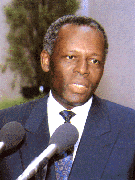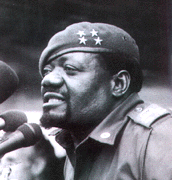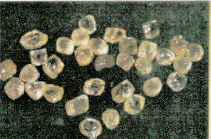

ICE CASE NUMBER: 32
CASE MNEMONIC: ANGOLA
CASE DESCRIPTION: Angola Diamond Mining and War
Draft Author: Lloyd R. Lewis III (June 14, 1997)
I. Identification
1. Abstract:
The Republic of Angola has been at war for over 35 years, first against the Portuguese and, after 1975 with outside help, between themselves. Angola has the potential to be a wealthy developed African nation since it possesses large petroleum and diamond reserves, but due to nearly 4 decades of war, remains to be seriously underdeveloped. The 20 year war between the Popular movement for the Liberation of Angola (MPLA) headed by Eduardo Dos Santos and the National Union for the Total Independence of Angola (UNITA) headed by Dr. Jonas Savimbi, has left the country covered with 10 to 20 million land mines. The 1994 Lusaka Peace Protocol signed by both the MPLA and UNITA leadership called for a cease-fire in the war for control of Angola. Today, an uneasy peace remains between the two opposing factions. Many strategic analysts believe that a large-scale civil war could recur due to UNITA's unwillingness to turn over its many diamond mines to the Angolan MPLA government under President Eduardo Dos Santos. UNITA has used its powerful position of controlling the diamond mines in the Lunda provinces to finance its guerrilla struggle against the MPLA government.
 |  |
| MPLA President Dos Santos | UNITA Leader Dr. Jonas Savimbi |
2. Description:
The Republic of Angola has been at a state of war for the last 35 years. First, Angola was conquered by the Portuguese and made a colony in 1576. During Portuguese Colonial rule, thousands of Angolans were sent to Portugal's other colony, Brazil as slaves up to the mid-1800s. Although other European colonial powers granted independence to their colonies after World War II, Portugal, on the other hand, kept Angola as a colony until 1975. Separate wars for independence sparked in 1961, when Portugal was unwilling to discuss eventual independence for Angola (Dept. of State 3). The combined forces of the Popular Movement for the Liberation of Angola (MPLA), the National Front for the Liberation of Angola (FNLA), and the National Union for the Total Independence succeeded in their struggle in removing the Portuguese colonial government in April, 1974 (Dept. Of State 3). The unified forces of the MPLA, the UNITA, and the FNLA succeeded in their rebellion not because of their success in battle, but to elements of the Portuguese Armed Forces that staged a coup at Lisbon in 1974 (Laidi 64). The Portuguese Armed Forces overthrew the Lisbon government in protest of ongoing African colonial wars. The Portuguese government removed the remaining elements of its colonial forces, replaced its military governor and established signed the Alvor Accord of 1974. The Alvor Accord called for a transitional government comprising all three independence movements (the MPLA, UNITA, and FNLA) and elections to prepare of independence in 1974. By the summer of 1975, the transitional government collapsed and a bloody struggle for power began between the MPLA, UNITA, and FNLA.
The MPLA controlled most of Angola by the mid 1980s and declared itself the legitimate government. The FNLA under Holden Roberto was no longer a significant military force. The continuing struggle for the control of Angola remained solely between the MPLA (under Jose dos Santos) and the UNITA (under Dr. Jonas Savimbi). The Angolan civil war soon became a continuation of the Cold War in Africa with the MPLA aided by the Soviets and Cuba; and the UNITA, backed by neighboring South Africa and the United States. The United States along with South Africa wanted to remove the strong Cuban military presence from the region. South Africa's CIA, "the Bureauof State Security" (BOSS) and the Central Intelligence Agency (CIA) provided such services as arms, ammunition, mercenaries, as well as intelligence to Jonas Savimbi's UNITA forces (Laidi 67).
International Peace Efforts
The Angola issue was responsible for Namibia's 1990 independence. Namibia,a colony of South Africa, was used primarily as a military and strategic support base of operations against the MPLA in neighboring Angola. Negotiations by South Africa, Angola, Cuba, and the United States involved a combination of demands including the removal of Cuban military forces from Angola andthe removal of South African Defense Forces from Namibia (Dept. Of State3). In the second phase of the negotiations, the MPLA government and UNITA concluded the Bicese Accord on May 31, 1991 (Anstee 10). The Bicese Accord called for a cease-fire, the formation of a new, unified national army, and the holding of Angola's first multi-party elections for a new President and National Assembly (Anstee 11-12).
Peace lasted in Angola until September 1992, when the MPLA candidate Eduardo Dos Santos won 49 % of the presidential vote. Jonas Savimbi, the UNITA presidential candidate received only 40% of the presidential vote. In a show of protest and an accusation that the MPLA committed election fraud, Savimbi resumed his guerrilla war against the Angolan government in October of 1992 (Dept. Of State 4). UNITA controlled more than half of Angola's national territory by 1993 (Dept. Of State 4).
Between 1993 and 1994, Angola was in a state of civil and economic chaos. The continuing conflict caused such internal problems as famine, the added dangers of millions of land mines, refugee crises, and the disruption of normal commerce. Millions of Angolans faced starvation due to the unavailability of farmland because of land mines and the southern African drought (Dept. of State 4). The United Nations Security Council condemned UNITA for escalating the conflict since many civilians were on the verge of death from starvation and disease. During the 1993-1994 crisis, the UNSC struggled in vain to reach a peace agreement. In Sept. 1993, the United Nations Security Council passed Resolution 864 which embargoed military goods and petroleum to UNITA(Dept. Of State 4).
The international community finally made progress in bringing the MPLA and UNITA factions to the bargaining table. In October 1993 peace talks under United Nations auspices, began in Lusaka, Zambia (Furley 197). The Lusaka Protocol was officiated on November 20, 1994 when MPLA President Eduardo Dos Santos and UNITA leader Dr. Jonas Savimbi signed the agreement and chose to work with the United Nations peace process (Dept. Of State4). Today, the government of Angola is working on assimilating the remaining UNITA forces into its national army and appointing UNITA leaders to prominent positions of government as a gesture to promote unity.
MAP Of Angola
UNITA and Diamond Mining

Despite recent progress in establishing peace in Angola, there are still several political and economic rifts between the MPLA and UNITA. For example, during the long years of civil war, UNITA captured the majority of Angola's diamond mines. The diamond mines served as the chief source of UNITA's money, arms, and fuel during the war. UNITA carved out a chunk of the diamond industry by taking the areas of Lunda Sul and Lunda Norte Provinces near the Zairian border.
According to African Business reporter Chris Gordon,"Since 1992,most of Angola's diamonds have been illegally produced and smuggled to Zaire and Antwerp. The Antwerp diamond market handles 80% of the world's rough, and 50% of cut diamonds each year (Misser 16). It is no secret that UNITA is responsible for the majority of this activity" (Gordon 14). UNITA profits from its diamond mining totaled about $430 million in 1995 (Gordon14). As a result of UNITA's incursion into the diamond market, the Angolan government's diamond sector, the Endiama Corporation, loses profits and is forced to tackle problems of mining property. Angola's Endiama Corporation hopes that UNITA leaders will agree to establish legitimate private diamond mining firms that will not threaten the economy of the Angolan government(Daley A10).
Angola's diamonds are considered to be among the best in the world and the highest quality in Africa. Endiama director, Paulinho Neto, states,"If there is no war and free circulation of people and goods, we could easily become the second largest producer in the world" (Matloff 2).The diamond rich territories of Lunda Sul and Lunda Norte have been invaded by people taking advantage of the chaos. The UNITA faction has employed thousands of illegal diamond miners (called garimpeiros in Portuguese) that have sold around $250 million in 1995-with $200 million going to UNITA coffers(Matloff 2). The garimpeiros are usually underpaid illegal immigrants that toil in river beds wearing only their underwear and clawing out stones with their hands under the watchful eyes of UNITA guards (Matloff 2). After the garimpeiros collect the diamonds the stones are then shipped to neighboring countries or even as far as West Africa and Europe. According to Chris Gordon,"UNITA,...is stocking up on diamond sales, either on the open market or to friendly buyers in Antwerp" (Gordon 14).
Strategic analysts believe a large-scale conflict could occur in the Lunda regions chiefly due to the areas isolation and valuable diamond resources. As Washington Post reporter Lynne Duke points out: "The Lunda, ...still cut off by mined roads, blown-up bridges and military roadblocks...is where war will return if the Lusaka Protocol breaks down" (Duke A:23). The Lunda region is the last stronghold of the UNITA faction. The majority of UNITA soldiers have begun turning themselves and their weapons over to UN peacekeepers, as mandated by the Lusaka Protocol. However, the Lunda region contains those powerful UNITA leaders who do not want to lose their economic power to the Angolan MPLA government. In response to the Lusaka Protocol, UNITA leaders are demanding that some of their diamond enclaves not be nationalized and left to UNITA for their own benefit. Out of all the UN cease-fire violations, 70 percent occurred in the Lunda provinces (Duke A:23). Along the Chicaparea, UNITA controls the west bank while the MPLA holds the east, establishing for a tense standoff that often ignites into fire-fights (Duke A:23). With the lack of an agreement between the MPLA and UNITA on control of the diamond territory, mining in the Lunda is open to whichever group has the superior firepower.
As a counter to the UNITA's previous monopoly on Angola's diamond industry, the Angolan diamond corporation, Endiama established a partnership With the powerful South African diamond corporation, De Beers (Gordon 14). Inan effort to protect their joint diamond ventures De Beers and Endiama have hired hundreds of South African mercenaries to guard their legitimate diamond enterprises against UNITA attacks (Duke A:23). The goal of De Beers is to buy up the illegally produced gems before they leave the country. In 1995,De Beers bought only $80 million worth of diamonds (Gordon 14). From 1992to 1993 De Beers bought $500 million to $800 million worth of diamonds from UNITA to maintain its grip on prices, despite having contracts with the Angolan government (Matloff 1). De Beers receives its diamonds through agents in the Lundas and Zaire.
An additional attempt by Endiama to halt UNITA mining operations took place in August 1995 when it signed a mining agreement with a Brazilian mining firm. The company, Odebrecht Mining Services (OMS) was given mining rights to the rich Luzamba area in the Cuango Valley (Gordon 14). Although the OMS/Endiama deal was legitimized, the UNITA elements were too powerful to remove, and the OMS was forced to strike deals with UNITA. UNITA has been supported covertly by several additional mining firms from South Africa and Israel (Gordon 14). As of today, the Brazilian based OMS has been unsuccessful in signing a mining rights agreement with UNITA. UNITA, with assistance from its foreign mining companies, has increased its mining operations in the Cuango Valley. UNITA continues to receive South African aid in the forms of hired scuba divers and mining equipment to mine the river-bed of Cuango Valley more effectively (Gordon 14).
Corporate Competition and Conflict
If UNITA did withdraw from the Luzamba in the Cuango Valley, and the mining rights went to OMS, De Beers would begin to lose its monopoly of diamonds. Odebrecht's (OMS) new mining contract would provoke conflict with De Beers who are still expecting to buy the Luzamba area under a contract drawn up six years ago (Gordon 14). OMS has no guarantee that its $90 million investment with Endiama to rehabilitate Luzamba will be a success. OMS is depending on the possibility that the diamond reserves in the Cuango Valley will be virtually untouched due to the difficult mining conditions in the area (Gordon 14). The Angolan government mining corporation, Endiama, faces additional setbacks. For instance, Endiama was forced to shut down its mining operations in Dundo and Njazi when two senior mining officials were assassinated by UNITA gunmen (Gordon 14). Since the Dundo region was abandoned by the Angolan government, UNITA can now exploit the area and smuggle weapons from neighboring Zaire.
In an effort to protect its diamond mining operations from UNITA intrusions, Endiama has ordered the military into the Cuango Valley with the orders"shoot to kill. Additionally, the Angolan Council of Ministers (at the request of Endiama), fearing that UNITA will continue to control diamond prospecting in the Cuango Valley, approved a De Beers bid for prospecting in the UNITA controlled territory of the Cuango (Gordon 16). The purpose behind this agreement was to have De Beers of South Africa to do the MPLA's dirty work for them: the protection of state diamond interests and the defeat of rogue UNITA forces. Once De Beers begins to move in its mining personnel and equipment, it will have to protect its operations. Throughout Angola's mining operations protection comes in the form of hired security specialists, or in other words mercenaries.
Angola's Oil Reserves
Several American and foreign petroleum companies including Chevron, Texaco, and Exxon are active in Angola, and U.S. companies have never been prohibited from operating in the country. Before the war for Angolan independence, Portugal administered and controlled all Angolan oil production. Throughout the MPLA-UNITA civil war, the MPLA used its control of petroleum to finance their army as well as to trade with foreign powers. Angolan oil exports are currently $4 billion per year, and total production is now nearly 700,000barrels per day (U.S. Dept. of State 5).
It was the exploitation of Angolan oil in Cabinda that the development of America's economic presence was most spectacularly visible in the early1970s (Laidi 52). The American company Gulf Oil began to exploit and commercialize Angolan oil in 1968 (Laidi 52). Starting at 1.4 million tons in 1968, production reached 9 million tons in 1974 (Laidi 52). Presently, Angola is the United State's third largest trading partner in Sub-Saharan Africa, after South Africa and Nigeria (U.S. Dept. of State 5). Angola is the source of about7 percent of U.S. imported oil (U.S. Dept. of State 5). Angola is also the site of the second largest direct U.S. investments in Sub-Saharan Africa(U.S. Dept. of State 5).
3. Location
Domain: Africa
Site: South Western Africa
Impact: Angola
II. Conflict and Environment Dimensions
4. Type and Level of Conflict
[Civil] and [Low and High]
5. Type of Environmental Problem:
a. Source Problems:
(1) Habitat
Territory [TERR]
6. Conflict Time Frame:
Limited warfare In Progress [INPROG] and could erupt into a large-scale Future Conflict [FUTURE]. 1975-present
The MPLA and UNITA conflict began in 1975 when the Portuguese set an Angolan transitional government. After the Portuguese left, the MPLA, FNLA, and UNITA began to fight for power. The large-scale fighting between the MPLA and UNITA factions ceased in 1994 with the signing of the Lusaka Protocol. Elements of UNITA are being integrated into the Angolan army, but some UNITA leaders prefer to keep control of the diamond rich enclaves in the Lunda regions near the Zairian border.
7. Environment Conflict Link: Direct
The variables I used to depict this situation are Political Ideology(Socialist vs. Democracy), Colonialism (the Legacy of Portuguese underdevelopment),and the struggle for Natural Resources (diamond mines).
Causal Loop Diagram

III. Related Material
8. Related Cases
9. Related Literature:
Anstee, Margaret Joan. Orphan of the Cold War. New York: St. Martins,1996.
Daley, Suzanne. "Foes in Angola Still at Odds, Over Diamonds"New York Times 15 Sept. 1995: A,1:2.
Duke, Lynne. "Of Diamonds and Death" Washington Post 16 Feb.1996: A, 23:1.
Furley, Oliver. Conflict in Africa. London: Tauris Academic Studies: London, 1995.
Gordon, Chris. "Hot Diamonds." African Business June 1996:14-16.
Laidi, Zaki. The Superpowers and Africa: The Constraints of a Rivalry:1960-1990. Chicago: Univ. Of Chicago, 1990.
Matloff, Judith. "Going for the Glint: Diamonds Keep the War in Angola Alive." Christian Science Monitor 18 Oct. 1995, 1:3.
Misser, Francis. "Dirty Dealings." African Business June 1996:16.
United States. Department of State. Background Paper. "Republic of Angola." Washington: GPO, 1997.
10. Related Web Sites: